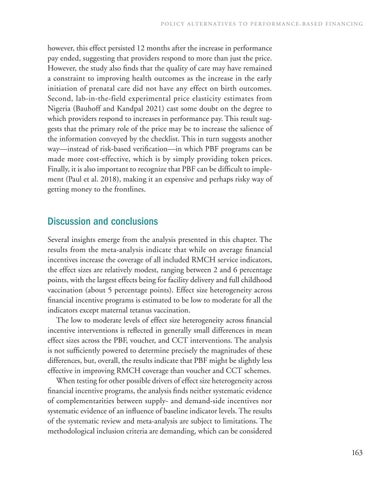POLICY ALTERNATIVES TO PERFORMANCE-BASED FINANCING
however, this effect persisted 12 months after the increase in performance pay ended, suggesting that providers respond to more than just the price. However, the study also finds that the quality of care may have remained a constraint to improving health outcomes as the increase in the early initiation of prenatal care did not have any effect on birth outcomes. Second, lab-in-the-field experimental price elasticity estimates from Nigeria (Bauhoff and Kandpal 2021) cast some doubt on the degree to which providers respond to increases in performance pay. This result suggests that the primary role of the price may be to increase the salience of the information conveyed by the checklist. This in turn suggests another way—instead of risk-based verification—in which PBF programs can be made more cost-effective, which is by simply providing token prices. Finally, it is also important to recognize that PBF can be difficult to implement (Paul et al. 2018), making it an expensive and perhaps risky way of getting money to the frontlines.
Discussion and conclusions Several insights emerge from the analysis presented in this chapter. The results from the meta-analysis indicate that while on average financial incentives increase the coverage of all included RMCH service indicators, the effect sizes are relatively modest, ranging between 2 and 6 percentage points, with the largest effects being for facility delivery and full childhood vaccination (about 5 percentage points). Effect size heterogeneity across financial incentive programs is estimated to be low to moderate for all the indicators except maternal tetanus vaccination. The low to moderate levels of effect size heterogeneity across financial incentive interventions is reflected in generally small differences in mean effect sizes across the PBF, voucher, and CCT interventions. The analysis is not sufficiently powered to determine precisely the magnitudes of these differences, but, overall, the results indicate that PBF might be slightly less effective in improving RMCH coverage than voucher and CCT schemes. When testing for other possible drivers of effect size heterogeneity across financial incentive programs, the analysis finds neither systematic evidence of complementarities between supply- and demand-side incentives nor systematic evidence of an influence of baseline indicator levels. The results of the systematic review and meta-analysis are subject to limitations. The methodological inclusion criteria are demanding, which can be considered 163

